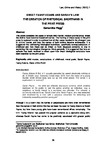Sweet Fanny Adams and Sarah’s Law: The Creation of Rhetorical Shorthand in the Print Press
| dc.contributor.author | Pegg, Samantha | |
| dc.date.accessioned | 2017-03-20T16:24:01Z | |
| dc.date.accessioned | 2017-04-11T08:38:43Z | |
| dc.date.available | 2017-03-20T16:24:01Z | |
| dc.date.available | 2017-04-11T08:38:43Z | |
| dc.date.issued | 2013 | |
| dc.identifier.citation |
Pegg, S. (2013) 'Sweet Fanny Adams and Sarah’s Law: The Creation of Rhetorical Shorthand in the Print Press', Law, Crime and History, 3(1), pp.76-96. Available at: https://pearl.plymouth.ac.uk/handle/10026.1/8876 | en_US |
| dc.identifier.issn | 2045-9238 | |
| dc.identifier.uri | http://hdl.handle.net/10026.1/8876 | |
| dc.description.abstract |
This article considers two cases of female child murder, modern and historical, where the victims have become household names. The framing of these cases in the print press is explored in order to address how similar cases resulted in the divergent use of victims’ names and how the names of both victims became emblematic. It is suggested that addressing ideological backdrops, specifically conceptualisations of childhood and how these can be linked to more disparate concerns, is vital in explaining this etymological divergence. More generally, it is suggested that how an episode has been received is reliant upon how these ideological constructs have been exploited by the print press. | en_US |
| dc.language.iso | en | en_US |
| dc.publisher | University of Plymouth | |
| dc.rights | Attribution 4.0 International (CC BY 4.0) | * |
| dc.rights.uri | https://creativecommons.org/licenses/by/4.0/ | * |
| dc.subject | child murder | en_US |
| dc.subject | constructions of childhood | en_US |
| dc.subject | moral panic | en_US |
| dc.subject | Sarah Payne | en_US |
| dc.subject | Fanny Adams | en_US |
| dc.subject | News of the World | en_US |
| dc.title | Sweet Fanny Adams and Sarah’s Law: The Creation of Rhetorical Shorthand in the Print Press | en_US |
| dc.type | Article | en_US |
| dc.type | Article | |
| plymouth.issue | 1 | |
| plymouth.volume | 3 | |
| plymouth.journal | SOLON Law, Crime and History |



